BNZ Currency Strategy: NZD/JPY: Set To Trend Higher?
By Mike Burrowes
- We expect a gradual appreciation in NZD/JPY over the next 12 months; to 63.00 by year-end and 71.00 by Q3 2012
- NZ’s economic growth outlook appears positive, while prospects for the Japanese economy look dim
- The prospect of higher NZ interest rates and/or an improvement in global risk sentiment should see demand for the carry-trade increase
- The main risk to our forecast is a sharper slowdown in global growth, meaning NZD/JPY falls below 58.00 before the end of the year
Developments
Over the past couple of months, NZD/JPY has largely taken its cues from the trials and tribulations if the European debt crisis. The flaring-up of the debt crisis and concerns over slowing global growth saw risk aversion rise in markets, leading to demand for the “safe haven” USD and JPY. At the same time, the risk sensitive NZD and AUD underperformed against the USD.
In early August, NZD/JPY reached a high just above 68.00 but subsequently fell to a low around 57.50 as the European debt crisis intensified. The proposed European rescue package to stem the debt crisis has helped risk sentiment stabilise and push NZD/JPY above 62.00.
As the chart below illustrates, NZD/JPY has spent the past couple of years trading choppily in a 58.00 to 68.00 range. The top of this range has coincided with periods of improved risk sentiment and rising NZ-JP interest rate differentials. Conversely, breaks below the bottom of this range occurred during periods of elevated risk aversion and falling NZ-JP interest rate differentials.
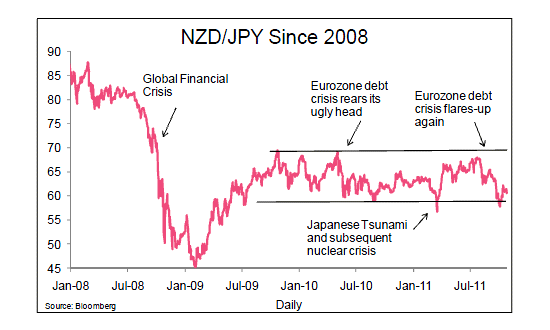
Is NZD/JPY set to trend higher?
Over the next 1-3 months, we see some upside potential on NZD/JPY towards 63.00. This is based off our working assumption for the Eurozone debt crisis to simmer down and concerns over global growth to ease. While the rescue package announced yesterday by the EU is very encouraging, it will not be the panacea to Europe’s woes. We expect trading to remain volatile as there are still a number of potential stumbling blocks in implementing the EU rescue plan.
Looking over the next 6-12 months, we expect NZD/JPY to gradually trend higher as NZ interest rates begin to rise and risk sentiment stabilises at more historically normal levels. At the same time, prospects for the Japanese economy appear dim, even as it slowly recovers from the devastating Tsunami and nuclear crisis early in the year.
The table below gives a concise snapshot of the major drivers of NZD/JPY and their likely direction over the next 1-3 months and 6-12 months. We expand further on each driver below.
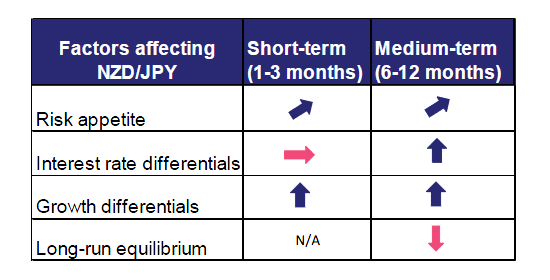
Relative growth differentials supportive
The recent concerns over slower global growth has seen many become less optimistic about the prospects for the NZ economy. While we acknowledge the NZ economic recovery has slowed recently, we still remain upbeat. Indeed, NZ export prices remain very high despite recent declines and the rebuild from the Christchurch earthquake is due to begin sometime next year.
We forecast 2.3% annual growth in NZ this year accelerating to 3.1% for the year 2012, although the recent global ructions may mean the recovery is slower than we previously expected. In contrast, the consensus forecast for Japan has a 0.5% annual decline for 2011 recovering to 2.2% for 2012. This means the NZ-JP growth differential will remain in NZ’s favour, helping to pressure NZD/JPY higher.
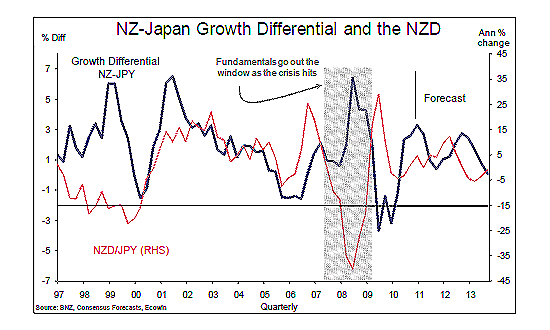
Interest rate differentials and risk appetite
The NZD is considered a “risk sensitive” currency. This is partly because the NZ economy is highly exposed to the fortunes of the global economy and ‘soft’ commodity prices. In contrast, the JPY is considered a “safe haven” currency, i.e. in times of elevated risk aversion the JPY tends to appreciate. This is partly because Japan has very high levels of private savings invested offshore. These savings tend to get repatriated back into JPY when investors become risk averse.
Because of this dynamic, the NZD/JPY tends to be highly volatile. Indeed, with concerns mounting over the US and European economies slipping back into recession, NZ interest rates have fallen sharply. At the same time, with interest rates in Japan already extremely low, there is little scope for further declines. The NZ-JP 3-year interest rate differential is currently 3.00%, from almost 3.70% in late-July.
What’s more, not only have NZ-JP interest rate differentials narrowed but volatility has increased. Indeed, our risk appetite index (scale 0 – 100%) fell below 30% as the Eurozone debt crisis intensified, well below its average of 50%. The EU rescue plan announced yesterday has seen the risk appetite index rebound to 40%.
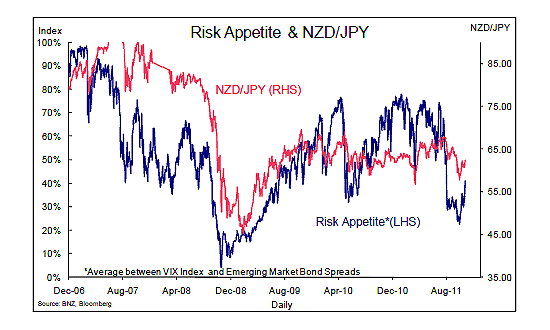
This is important for NZD/JPY because the necessary conditions for the carry-trade (where speculators sell a low yielding currency and buy a high yielding currency) are a positive interest rate differential and low volatility. As the chart below illustrates, the NZD is less attractive than other popular carry-trades, namely the Brazilian real, South African rand and Australian dollar.
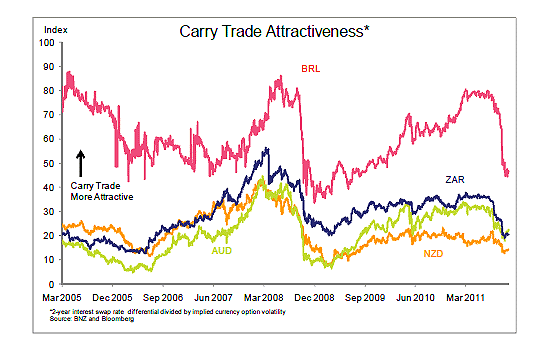
Data on speculative positioning by Japanese retail clients (another popular vehicle for the carry-trade) backs up our claim of muted carry-trade demand for NZD/JPY. For example, speculative positioning in NZD/JPY has remained flat while positioning in AUD/JPY is extremely long relative to history. We will watch carefully for any signs of a pickup in carry-trade demand in NZD/JPY when the RBNZ begins hiking rates or if volatility in FX markets drops significantly.
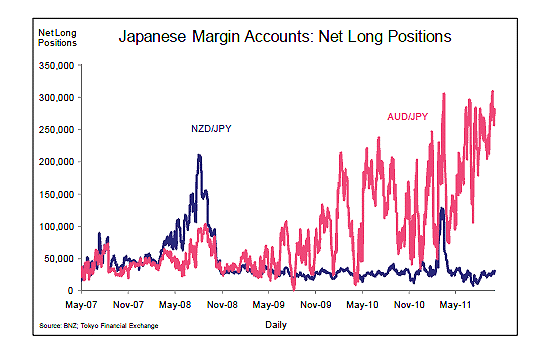
Over the next 12 months, we expect NZD/JPY to become more popular amongst carry-trade type investors. While we recently pushed out our call for the RBNZ to begin hiking rates to June 2012 (from March 2012), the RBNZ still remains the only developed-world central bank where any rate hikes are priced in over the next 12 months. In addition, we remain more hawkish than the market, expecting 75bps of hikes over the next 12 months from the RBNZ. The OIS market is currently pricing around 40bps of hikes over the same period.
Therefore, the prospect of higher rates in NZ and improvement in global risk sentiment would likely see demand pick-up for NZD/JPY, helping to push the cross gradually higher.
Maturing offshore NZD bond issuance a drag
Similar to diminished NZD/JPY speculative flows, issuance of offshore NZD bonds have continued to languish. Indeed, issuance data of Eurokiwi bonds (NZD bonds issued in offshore markets, excluding Japan) and Uridashi bonds (NZD bonds issued in Japan) support this view. So far in 2011, only NZ$2.01b of Eurokiwi and Uridashi bonds were issued (blue bars below), well short of the NZ$5.33b of bonds that have matured (red bars below). The stock of outstanding Eurobonds now stands at NZ$21b, well below the peak of NZ$53b.
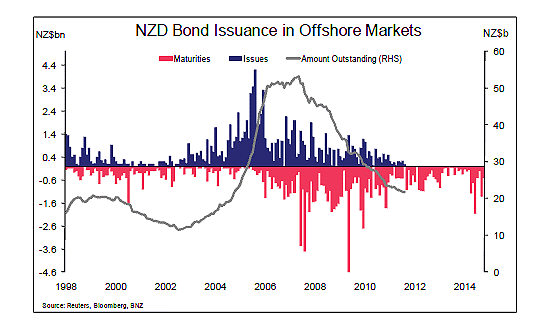
We do not expect Eurobond issuance to reach the giddy heights seen during the 2006-2008 period, even if NZ interest rates rise and risk appetite improves. As such, there is likely to be less support for NZD/JPY than compared to the period 2004 – 2008.
Strategy Conclusions
We expect NZD/JPY to gradually appreciate over the next 12 months to above 71.00. However, concerns over the European debt crisis and slow global growth will likely mean trading in FX markets remains volatile in the near-term. As such, we would view any dips in NZD/JPY below 58.00 as a good medium-term buying opportunity.
We don’t expect to see a large resurgence in carry-trade activity and offshore NZD bond issuance over the next 12 months, like prior to the Global Financial Crisis. Therefore, the move higher in NZD/JPY over the next 12 months will be much more muted than the rally in NZD/JPY during 2006 – 2007.
See our interactive exchange rates charts here.
Mike Burrowes is part of the BNZ research team.
We welcome your comments below. If you are not already registered, please register to comment
Remember we welcome robust, respectful and insightful debate. We don't welcome abusive or defamatory comments and will de-register those repeatedly making such comments. Our current comment policy is here.